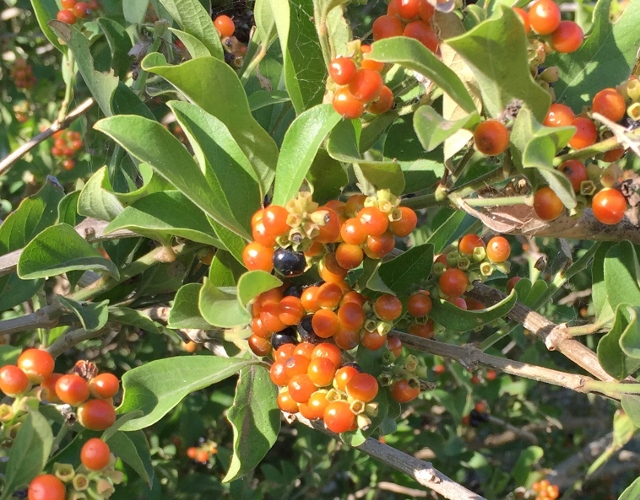Story and photos by Anita Westervelt, Texas Master Naturalist

“It’s tree planting time” is a familiar mantra around the Valley amongst native plant advocates during these cooler months. Trees, shrubs, vines, plants, they all benefit from being planted while dormant or partially dormant: less shock to their system, less stress from summer’s severe heat.
A good rule of thumb when planting is to water the hole well, let it drain and then put the plant in and fill with additional soil. Tamp it in and water it again. Watering a couple of times a week for the first couple of weeks helps plants establish. Plants get nutrients from the soil; the nutrients are dissolved in water and absorbed by the plant’s roots when it takes up water. Once established, native plants are mostly maintenance free.
Native plants are those plants that have survived climatic and elemental conditions during hundreds of years in a specific geographic region. For instance, plants considered native to the Rio Grande Valley have survived diverse and sometimes harsh and extreme environmental conditions: drought, floods, heat, freeze, sun, wind, salt and snow — sometimes all in the course of one year.
That test of time delivers plants that are hardy; plants that can resist drought, pest and disease. It also gives us plants that attract birds, beneficial insects and pollinators; provide larval food for butterflies and moths; and food for wildlife from nectar, fruits, seeds and leaves.
Some plants deliver all this, like the shrub Berlandier’s fiddlewood, Citharexylum berlandieri. This fast-growing shrub is thorn free. It can grow from eight to 20 feet tall, but usually to around eight feet with a hefty girth. Planted as a standalone specimen, the slim, leafy branches can drape all around in symmetrical order. It blooms and berries all year, making it invaluable in a butterfly garden and inviting raucous chachalacas, chatty green jays, tuneful mockingbirds and melodious song birds to its branches and fruit.

Berlandier’s fiddlewood’s northern most range is the Lower Rio Grande Valley and south to Oaxaca, Mexico.
The tiny white flowers have an excellent nectar rating that draws insects. Throughout the year, the tight clumps of berries display myriad colors from pale green to umber, bronze, deep orange and black when ripe. They are eaten by a host of birds. The shrub’s dense growth offers a perch for birds, night shelter for sleeping butterflies, a jungle gym for tiny black-capped titmice darting after bugs and a venue for song birds. It is possibly a host plant to the common buckeye butterfly.
Plant Berlandier’s fiddlewood in full or partial sun. Interestingly, some specimens may take a few years to flower and fruit, or never fruit at all; play it safe; plant more than one. A non-fruiting shrub can later be removed to make way for other plants, if needed.
Once established, the shrub requires little maintenance. Pruning isn’t necessary but the shrub can be shaped as a hedge or trimmed to desired shapes. The leaves may turn orange when the plant is stressed or during a drought.